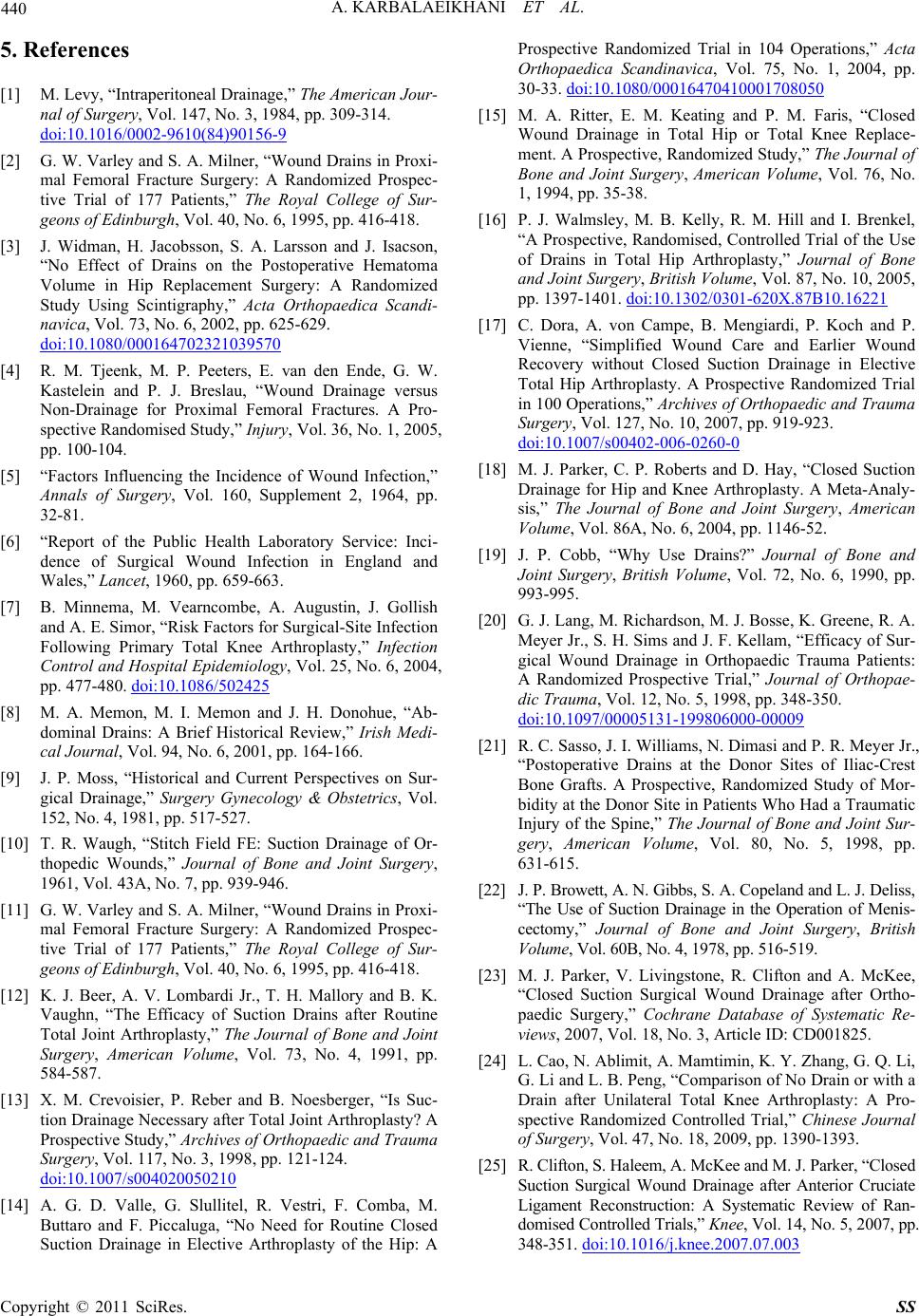
440 A. KARBALAEIKHANI ET AL.
5. References
[1] M. Levy, “I ntr aper it onea l Drai nage ,” The American Jour-
nal of Surgery, Vol. 147, No. 3, 1984, pp. 309-314.
doi:10.1016/0002-9610(84)90156-9
[2] G. W. Varley and S. A. Milner, “Wound Drains in Proxi-
mal Femoral Fracture Surgery: A Randomized Prospec-
tive Trial of 177 Patients,” The Royal College of Sur-
geons of Edinburgh, Vol. 40, No. 6, 1995, pp. 416-418.
[3] J. Widman, H. Jacobsson, S. A. Larsson and J. Isacson,
“No Effect of Drains on the Postoperative Hematoma
Volume in Hip Replacement Surgery: A Randomized
Study Using Scintigraphy,” Acta Orthopaedica Scandi-
navica, Vol. 73, No. 6, 2002, pp. 625-629.
doi:10.1080/000164702321039570
[4] R. M. Tjeenk, M. P. Peeters, E. van den Ende, G. W.
Kastelein and P. J. Breslau, “Wound Drainage versus
Non-Drainage for Proximal Femoral Fractures. A Pro-
spective Randomised Study,” Injury, Vol. 36, No. 1, 2005,
pp. 100-104.
[5] “Factors Influencing the Incidence of Wound Infection,”
Annals of Surgery, Vol. 160, Supplement 2, 1964, pp.
32-81.
[6] “Report of the Public Health Laboratory Service: Inci-
dence of Surgical Wound Infection in England and
Wales,” Lancet, 1960, pp. 659-663.
[7] B. Minnema, M. Vearncombe, A. Augustin, J. Gollish
and A. E. Simor, “Risk Factors for Surgical-Site Infection
Following Primary Total Knee Arthroplasty,” Infection
Control and Hospital Epidemiology, Vol. 25, No. 6, 2004,
pp. 477-480. doi:10.1086/502425
[8] M. A. Memon, M. I. Memon and J. H. Donohue, “Ab-
dominal Drains: A Brief Historical Review,” Irish Medi-
cal Journal, Vol. 94, No. 6, 2001, pp. 164-166.
[9] J. P. Moss, “Historical and Current Perspectives on Sur-
gical Drainage,” Surgery Gynecology & Obstetrics, Vol.
152, No. 4, 1981, pp. 517-527.
[10] T. R. Waugh, “Stitch Field FE: Suction Drainage of Or-
thopedic Wounds,” Journal of Bone and Joint Surgery,
1961, Vol. 43A, No. 7, pp. 939-946.
[11] G. W. Varley and S. A. Milner, “Wound Drains in Proxi-
mal Femoral Fracture Surgery: A Randomized Prospec-
tive Trial of 177 Patients,” The Royal College of Sur-
geons of Edinburgh, Vol. 40, No. 6, 1995, pp. 416-418.
[12] K. J. Beer, A. V. Lombardi Jr., T. H. Mallory and B. K.
Vaughn, “The Efficacy of Suction Drains after Routine
Total Joint Arthroplasty,” The Journal of Bone and Joint
Surgery, American Volume, Vol. 73, No. 4, 1991, pp.
584-587.
[13] X. M. Crevoisier, P. Reber and B. Noesberger, “Is Suc-
tion Drainage Necessary after Total Joint Arthroplasty? A
Prospective Study,” Archives of Orthopaedic and Trauma
Surgery, Vol. 117, No. 3, 1998, pp. 121-124.
doi:10.1007/s004020050210
[14] A. G. D. Valle, G. Slullitel, R. Vestri, F. Comba, M.
Buttaro and F. Piccaluga, “No Need for Routine Closed
Suction Drainage in Elective Arthroplasty of the Hip: A
Prospective Randomized Trial in 104 Operations,” Acta
Orthopaedica Scandinavica, Vol. 75, No. 1, 2004, pp.
30-33. doi:10.1080/00016470410001708050
[15] M. A. Ritter, E. M. Keating and P. M. Faris, “Closed
Wound Drainage in Total Hip or Total Knee Replace-
ment. A Prospective, Randomized Study,” The Journal of
Bone and Joint Surgery, American Volume, Vol. 76, No.
1, 1994, pp. 35-38.
[16] P. J. Walmsley, M. B. Kelly, R. M. Hill and I. Brenkel,
“A Prospective, Randomised, Controlled Trial of the Use
of Drains in Total Hip Arthroplasty,” Journal of Bone
and Joint Surgery, British Volume, Vol. 87, No. 10, 2005,
pp. 1397-1401. doi:10.1302/0301-620X.87B10.16221
[17] C. Dora, A. von Campe, B. Mengiardi, P. Koch and P.
Vienne, “Simplified Wound Care and Earlier Wound
Recovery without Closed Suction Drainage in Elective
Total Hip Arthroplasty. A Prospective Randomized Trial
in 100 Operations,” Archives of Orthopaedic and Trauma
Surgery, Vol. 127, No. 10, 2007, pp. 919-923.
doi:10.1007/s00402-006-0260-0
[18] M. J. Parker, C. P. Roberts and D. Hay, “Closed Suction
Drainage for Hip and Knee Arthroplasty. A Meta-Analy-
sis,” The Journal of Bone and Joint Surgery, American
Volume, Vol. 86A, No. 6, 2004, pp. 1146-52.
[19] J. P. Cobb, “Why Use Drains?” Journal of Bone and
Joint Surgery, British Volume, Vol. 72, No. 6, 1990, pp.
993-995.
[20] G. J. Lang, M. Richa rdson, M. J. Bosse, K. Gre ene, R. A.
Meyer Jr., S. H. Sims and J. F. Kellam, “Efficacy of Sur-
gical Wound Drainage in Orthopaedic Trauma Patients:
A Randomized Prospective Trial,” Journal of Orthopae-
dic Trauma, Vol. 12, No. 5, 1998, pp. 348-350.
doi:10.1097/00005131-199806000-00009
[21] R. C. Sasso, J. I. Williams, N. Dimasi and P. R. Meyer Jr.,
“Postoperative Drains at the Donor Sites of Iliac-Crest
Bone Grafts. A Prospective, Randomized Study of Mor-
bidity at the Donor Site in Patients Who Had a Traumatic
Injury of the Spine,” The Journal of Bone and Joint Sur-
gery, American Volume, Vol. 80, No. 5, 1998, pp.
631-615.
[22] J. P. Browett, A. N. Gibbs, S. A. Copeland and L. J. Deliss,
“The Use of Suction Drainage in the Operation of Menis-
cectomy,” Journal of Bone and Joint Surgery, British
Volume, Vol. 60B, No. 4, 1978, pp. 516-519.
[23] M. J. Parker, V. Livingstone, R. Clifton and A. McKee,
“Closed Suction Surgical Wound Drainage after Ortho-
paedic Surgery,” Cochrane Database of Systematic Re-
views, 2007, Vol. 18, No. 3, Article ID: CD001825.
[24] L. Cao, N. Ablimit, A. Mamtimin, K. Y. Zhang, G. Q. Li,
G. Li and L. B. Peng, “Comparison of No Drain or with a
Drain after Unilateral Total Knee Arthroplasty: A Pro-
spective Randomized Controlled Trial,” Chinese Journal
of Surgery, Vol. 47, No. 18, 2009, pp. 1390-1393.
[25] R. Clifton, S. Haleem, A. McKee and M. J. Parker, “Closed
Suction Surgical Wound Drainage after Anterior Cruciate
Ligament Reconstruction: A Systematic Review of Ran-
domised Controll ed Trials,” Knee, Vol. 14, No. 5, 2007, p p.
348-351. doi:10.1016/j.knee.2007.07.003
Copyright © 2011 SciRes. SS